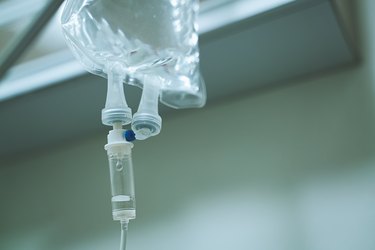
If you have diabetes, you know that diabetic ketoacidosis (DKA) is a potentially fatal condition that can occur when your blood sugar runs too high and your insulin levels dip too low. But did you know that a common household item could be the basis of a treatment for a serious DKA complication?
That complication is mucormycosis, an aggressive fungal infection. Baking soda (sodium bicarbonate) may limit the spread of this potentially deadly bug.
Video of the Day
Video of the Day
Although baking soda is probably as close as your kitchen cabinet, a medical grade form of sodium bicarbonate must be administered intravenously in a hospital by trained professionals when it is used to treat mucormycosis in DKA, stresses Ashraf S. Ibrahim, PhD, a professor of medicine in the division of infectious diseases at the David Geffen School of Medicine at UCLA, Los Angeles, and author of a study on the use of sodium bicarbonate for mucormycosis in DKA, published in the May 9, 2016, issue of the Journal of Clinical Investigation.
The Mechanism of Diabetic Ketoacidosis
When you have diabetes, your body can't make enough, or any, of the hormone insulin or use it properly. When insulin can't move blood sugar (glucose) to your cells for energy, glucose builds up, according to the National Institute of Diabetes and Digestive and Kidney Diseases.
If your cells don't get the glucose they need for energy, your body starts to burn fat for energy, processing it into a fuel called ketones, creating the condition known as DKA. Ketones make the blood more acidic and are poisonous in high levels. Left untreated, DKA can lead to coma and death, warns the American Diabetes Association (ADA).
DKA occurs in people with type 1 diabetes or advanced type 2 diabetes, the form of the disease most closely related to obesity, says Miami-based dietitian Tatiana Larionova, LDN, CNS. "Insulin levels drop, and the cells in the body are not able to take in glucose for energy," she says. "In response, ketone bodies are produced to provide energy. However, the buildup of ketones in the blood makes it more acidic and can poison the body."
The ADA suggests checking urine for ketones with a test strip when your blood glucose is more than 240 milligrams per deciliter of blood. Symptoms of DKA can include decreased alertness, quickened breathing, dry skin and mouth, flushing, frequent urination or thirst, fruity-smelling breath, headache, body aches, nausea, vomiting and stomach pain. Treatment for DKA itself typically takes place at the hospital and is aimed at reversing high blood sugar with insulin, the ADA notes.
How Sodium Bicarbonate Helps
Sodium bicarbonate can help stop the spread of mucormycosis in two important ways, Dr. Ibrahim explains. It neutralizes acid present in DKA, and it also reverses many of the processes that allow this infection to spread throughout the body unchecked. It can even be beneficial when acidosis isn't severe because sodium bicarbonate is likely to halt the growth of the fungus as well as reduce acid levels, he adds.
The treatment can be coupled with iron chelation, which removes extra iron from your body, explains the Aplastic Anemia and MDS International Foundation. Cutting the fungus off from iron also helps stop its spread, Dr. Ibrahim says.
Risks of sodium bicarbonate therapy include alkalemia, an elevation of your blood's pH level (a measure of its acidity or alkalinity). "Mucormycosis can be fatal if not treated, so the risk of this treatment justifies the means," Dr. Ibrahim says. Other current treatment options for mucormycosis include surgery and antifungal therapy, he adds.
However, he's quick to caution that sodium bicarbonate is not a treatment for DKA in the absence of mucormycosis, making it important to know the signs of mucormycosis, which can include fever, facial paralysis, slurred speech and abnormalities of the facial nerves.
Read more: What to Do If Your Blood Sugar Is Over 400
- Ashraf S. Ibrahim, PhD, professor of medicine, division of infectious diseases, David Geffen School of Medicine at UCLA, Los Angeles
- Journal of Clinical Investigation: “Bicarbonate Correction of Ketoacidosis Alters Host-Pathogen Interactions and Alleviates Mucormycosis”
- National Institute of Diabetes and Digestive and Kidney Diseases: “What Is Diabetes?”
- Aplastic Anemia and MDS International Foundation: “Iron Chelation”
- Tatiana Larionova, MS, CNS, LDN, dietitian, Miami
- American Diabetes Association: “DKA (Ketoacidosis) & Ketones”
Is this an emergency? If you are experiencing serious medical symptoms, please see the National Library of Medicine’s list of signs you need emergency medical attention or call 911.